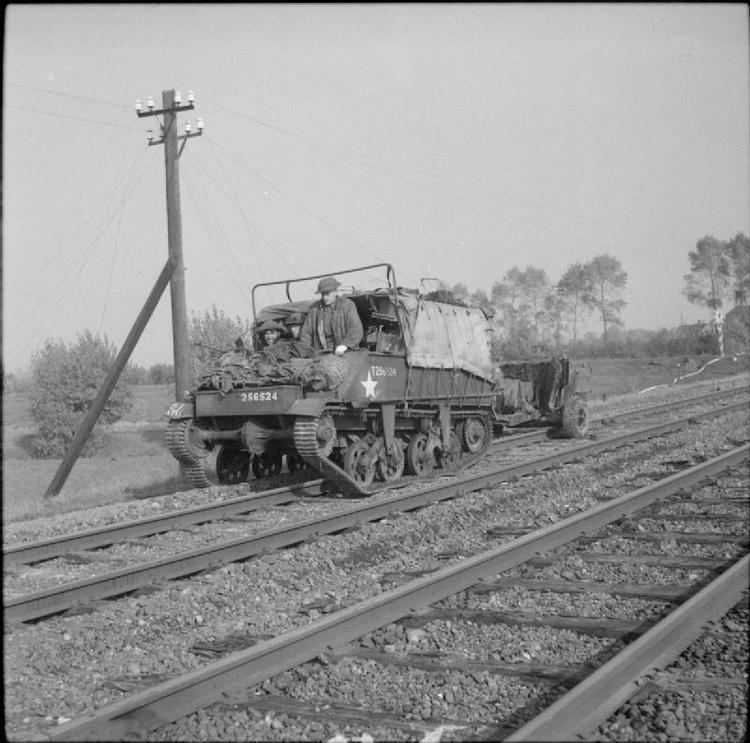Wars Second World War | In service 1939 -1960s | |
 | ||
Used by British & Commonwealth.Post-war Danish, Dutch and Belgian armies | ||
The Loyd Carrier was one of a number of small tracked vehicles used by the British and Commonwealth forces in the Second World War to transport equipment and men about the battlefield. Alongside the Bren, Scout and Machine Gun Carriers, they also moved infantry support weapons.
Contents
Design and development
The Loyd Carrier was built upon the mechanicals (engine, gearbox and transmission) of a 15 cwt 4x2 Fordson 7V truck with mild steel bodywork to which armour plate (referred to as 'BP Plate' in Loyd manuals) was bolted (to the front and upper sides) depending on application. The engine was at the rear of the Carrier with the radiator behind rather than in front. The transmission then took the drive forward to the axle at the very front where it drove the tracks. Both the front drive sprockets and idlers (which were also sprocketed) at the rear of the tracks were fitted with brakes, actuated by a pair of levers by the driver. To turn the vehicle to the left, the brakes were applied on that side and the Carrier would slew round the stopped track.
The upper hull covered the front and sides but was open to the rear and above; as the Carrier was not expected to function as a fighting vehicle this was not an issue. To protect the occupants from the weather a canvas tilt could be put up; this was standard fitment from the factory.
As part of the rapid development program and use of pre-designed parts the Loyd used parts from other vehicles. From the Universal Carrier the track, drive sprockets, and Horstmann suspension units. From the Fordson 7V, the chassis, engine, gearbox, torque tube and front axle. The brake drums and back plates were designed specifically for the Loyd.
The Army tested the Loyd Carrier in 1939 and placed an initial order for 200 as the Carrier, Tracked, Personnel Carrying i.e. a personnel carrier. Initial deliveries were from Vivian Loyd's own company but production moved to the larger firms including the Ford Motor Company and Wolseley Motors (13,000 between them) and Dennis Brothers Ltd, Aveling & Barford and Sentinel Waggon Works. Total production of the Loyd Carrier was approximately 26,000.
Second World War
By far the most notable use of the Loyd was in the TT (Tracked Towing) configuration where it pulled the 6 Pdr anti-tank gun from the Normandy landings of 1944 through to the end of the war. There are many wartime photographs of Loyds in action in Normandy, and a number were photographed destroyed in the well-known battle of Villers-Bocage in 1944. The Loyd Carrier was also paired with Caterpillar D8 tractors in service with Royal Electrical and Mechanical Engineers for tank recovery - the Carrier carrying spare equipment for the tractor.
Post-war
Both Belgium and the Netherlands bought Loyd TTs from the British Army; they were still in Belgian Army ownership up to at least 1963 as engine rebuild plates have been seen with this date in original Belgian vehicles.
A Belgian variant was the CATI 90 (Canon antitank d'infanterie automoteur 90mm), a self-propelled gun in use from 1954 to 1962. The vehicle served in infantry units with a paired ammunition carrier.
Although some vehicles were sold on into private ownership for farming use (a 1941 No1Mk1 TPC with a ploughing conversion still exists in Nottinghamshire, UK), a number were placed as targets on Belgian ranges.
Variants
Loyd carriers were available in three "numbers" which were available in two "marks"; all manufactured during wartime:
The two marks were:
Roles
There were not many differences between variants, mainly seating and armour plate location:
